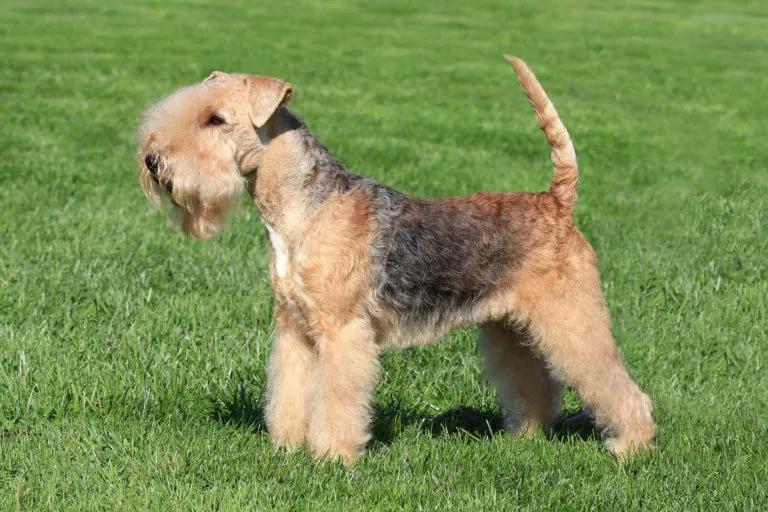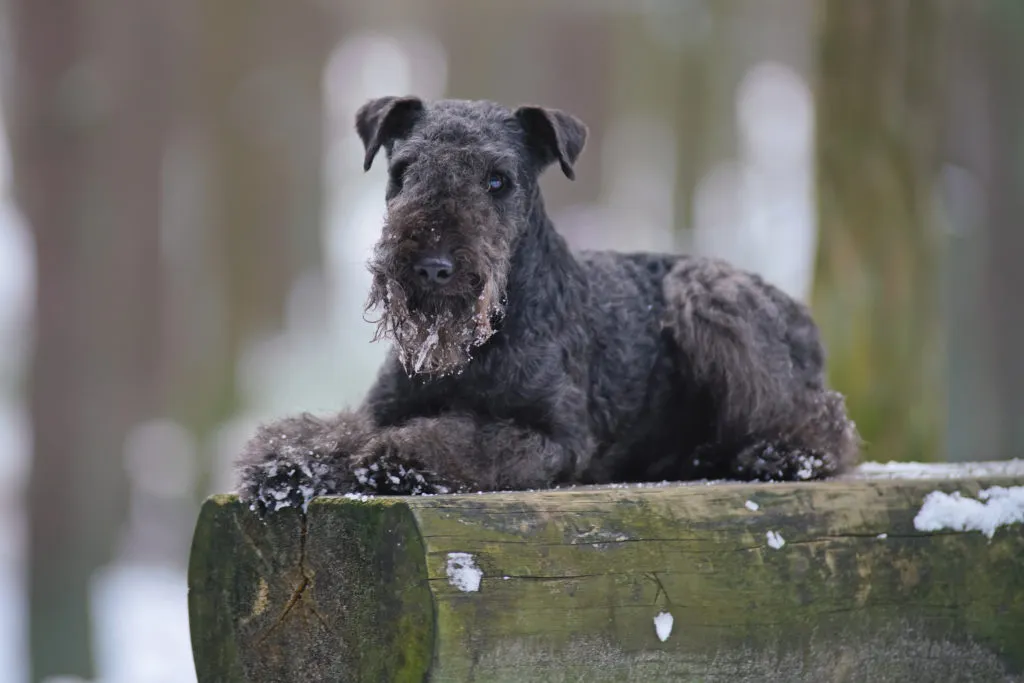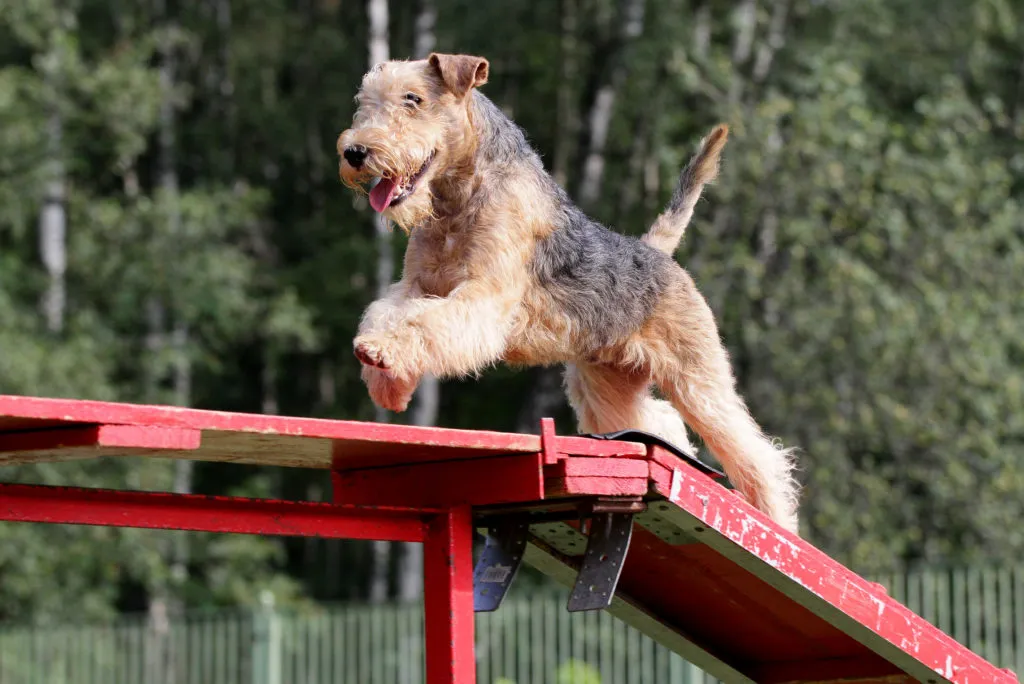Medium Size Poodle
Despite being one of the smallest high-legged terriers from North England, the Lakeland Terrier boasts immense courage and self-confidence. This former fox hunter, who resembles the Welsh Terrier, becomes a friendly and child-loving family dog who loves action the most when given consistent training.

© Vincent / stock.adobe,com
Confidence on four legs: the Lakeland Terrier knows no fear
Jumping over ditches and obstacles, frolicking in water, playing with other dogs, digging holes in the garden, or chasing mice in the bushes: the energetic Lakeland Terrier prefers to be on the move all day and enjoys every kind of change.
The enduring little dog doesn’t know tiredness or boredom. Therefore, it’s not surprising that the Lakeland Terrier hates nothing more than being “locked up” at home for hours. Anyone interested in this English breed dog needs one thing above all: endurance!
Active families who enjoy spending a lot of time outdoors will certainly delight in the Lakeland Terrier. As a former hunting dog, the English breed is not only very enduring and fearless but also very people-oriented and attentive.
Under loving and consistent leadership, it develops into an easy-to-handle companion dog who always stands by its people and knows how to behave in the city, on the bus, or in a restaurant. However, in situations where its human favours another dog and possibly pets it, the otherwise uncomplicated dog might become jealous.
Besides jealousy, the Lakeland Terrier also has a weakness for hunting – after all, this trait has been bred into it for decades. Originally employed for fox hunting to protect sheep herds, it skilfully, fearlessly, and swiftly pursued the predators into their dens.
A certain hunting instinct remains to this day, although it has become less pugnacious or audacious as a household dog in recent years. However, if it receives sufficient occupation that challenges it both physically and mentally (for example, in dog sports), the Lakeland Terrier, despite its terrier lineage, proves to be a relatively calm and balanced character who spreads a lot of good cheer.
When encountering the Lakeland Terrier for the first time on the street, in the park, or at the dog sport arena, one might initially think it’s a Welsh Terrier.
True terrier enthusiasts and experts of different breeds will rightly point out the differences: the Lakeland, with a maximum height of 37cm and a weight of about 7kg, is slightly smaller and lighter than the Welsh. Its head is slightly broader and shorter, although it also has the characteristic long shape.
Additionally, the Lakeland differs from the Welsh in coat colour: unlike this terrier breed, which must have black saddle markings on a tan coat, the Lakeland may be solid tan, red, wheat, red-grizzle, liver, blue/tan, or black.
However, both breeds share the wiry and weather-proof coat structure with coarse, slightly curled topcoat and dense undercoat.
Despite its small stature, the Lakeland Terrier makes an incredibly powerful and proud impression. Its compact body is very muscular and in terms of endurance, it is on par with its larger terrier relatives.
It bursts with vitality, which is most evident in its alert expression and V-shaped ears that tilt forward as if in anticipation. This lively and self-confident impression of the English Lakeland is further emphasized by its upright posture and tail.
 © Eudyptula / stock.adobe,com
© Eudyptula / stock.adobe,com
Naturally, the small terrier had to be brave and self-confident in its original work. Fearlessly, it hunted down any fox approaching the farmer’s sheep herd and pursued the predator among the rocks and stones of its northern English homeland. It would keep going until it flushed the fox out of its hiding place and didn’t hesitate to kill it in an emergency.
The hunting grounds of the Lakeland Terrier were in the high, barren, lake-rich county of Cumberland in north-west England, where this skilled hunter had been bred purposefully since the early 19th century.
When Lord Lonsdale, the first president of the Lakeland Terrier Association, named the breed in reference to the lakes of its homeland, already 70 years of pedigree history had been maintained.
Bred initially as the Cumberland Terrier, Westmoreland Terrier, or Fell Terrier, the Lakeland was developed from the “Old English Black and Tan Terrier”, the Bedlington and the Border, with Bedlington improving its temperament and the Border enhancing robustness with its wiry, water-resistant hair. Despite this long history of targeted breeding, the English Kennel Club only recognised the breed in 1928.
It wasn’t until after World War II that the breed made its way to mainland Europe and America, peaking with the recognition by the Fédération Cynologique Internationale (FCI) in 1954.
As the owner of a purebred Lakeland Terrier, you typically don’t need to worry about frequent vet visits and high treatment costs.
However, like all dogs, the Lakeland should be vaccinated and regularly checked by a vet to detect and treat potential infections or ailments early on.
In addition, it’s crucial that the breed’s coat is professionally trimmed every three to four months from about 18 months of age. Thankfully, in everyday life, the Lakeland Terrier’s wiry, water-resistant coat makes it very easy to care for.
Compared to care, training the Lakeland Terrier is a bit more demanding. Like all terriers, the Lakeland has a stubborn streak and likes to test its limits – unless its owner has already shown it those boundaries as a puppy.
Consistency from the start with clear commands will surprise you with just how eager to learn and obedient the Lakeland Terrier can be. A consistent but loving training approach based on positive reinforcement will definitely pay off with this lively terrier, greatly simplifying the everyday life of both dog and owner.
Thanks to its friendly and people-oriented nature and compact body size, the Lakeland Terrier also suits city life. However, bear in mind that its hunting past means it must be sufficiently exercised and occupied.
If not utilised for hunting, it should be given alternative activities, such as dog sports. Long and engaging walks in the park or nearby forest are also a must. Anyone considering a Lakeland Terrier should have enough time to actively engage with the dog.
For single individuals who work full-time, have to leave their dog alone a lot, and prefer slippers over running or hiking shoes in their spare time, this terrier is certainly not suitable.
Understimulated and bored dogs develop unwanted behaviours which can quickly lead to serious issues in cohabitation. This includes persistent barking with the high-pitched, penetrating voice for which the Lakeland is also known.
However, if the little guy is sufficiently exercised and challenged throughout the day, allowed to romp during walks, and play with other dogs, barking should not pose any problems. The more it is allowed to expend energy outdoors, the calmer it will be indoors.
Living with children will also work very well in this case – after all, the lively little dog will never tire of playing with the little ones. It is important that children learn to respect the dog’s needs and be considerate.
Despite its tireless energy, the Lakeland Terrier is satisfied with relatively small food portions. It’s important that the mealtime includes all necessary nutrients the active dog needs.
If you prepare the food yourself, make sure to include proteins, vegetables, a high-quality oil, and possibly pasta or rice in the dog’s food bowl.
In recent years, BARFing has become quite popular among dog owners, a “biologically appropriate raw feeding”. However, this method of feeding the dog requires good knowledge and specific understanding of nutrient proportions in food and the dog’s needs.
For those who don’t have the time, high-quality dry food is an excellent and healthy alternative. Due to the Lakeland Terrier’s long whiskers, wet food is less suitable and definitely requires extensive cleaning after feeding.
 © zelenka68 / stock.adobe.com
© zelenka68 / stock.adobe.com
If you love high-spirited dogs and enjoy many outdoor activities, whether in the forest, park, field, or dog sport arena, the Lakeland Terrier will certainly satisfy you.
At the same time, thanks to its small size and eagerness to learn, this breed dog is also a fitting companion for city dwellers and novice dog owners – provided they have enough time and dedication to engage with their challenging breed dog.
If you’re uncertain whether the Lakeland Terrier is the perfect match for you and your family, consult experienced terrier owners and Lakeland breeders who can provide you with valuable advice and tips.
Fans of the Bearded Collie agree that those who aren't familiar with this dog breed simply have to get acquainted with it. And those who have experienced how a Bearded Collie bolts across meadows with its flowing fur, how it rolls around full of energy and joy and how it attentively and observantly takes into account its owners wishes become simply addicted to this original dog breed and its unique charm.
The Goldendoodle isn't a breed, but a pairing between Golden Retrievers and Medium or Standard Poodles. Marketed as a low-maintenance dog for allergy sufferers, this hybrid is enjoying increasing popularity amongst dog lovers, similar to the Labradoodle.